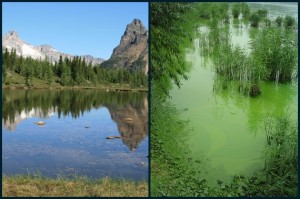What’s the deal with Lake Eutrophication?
A continuation of the study started in 1967 on Lake Ontario was carried out in the Great Lakes (Superior, Huron, Erie, Ontario, and Michigan) to determine the species and abundance of crustaceans and zooplankton during the summer months. Summer was chosen because it is the period when all of the Great Lakes reach maximum temperature and production. This
study focuses on the relationship between temperature and lake eutrophication. Eutrophication occurs when nitrogen and phosphorous levels are increased. The increase in nitrogen and phosphorous levels accelerates the growth of algae and
plants which deplete both oxygen levels and biodiversity.  A general trend was seen in oligotrophic (water poor in dissolved nutrients and rich in dissolved oxygen) Lake Superior to eutrophic Lake Erie. The trend occurring is a significant decrease
of Calanoids and an increased predominance of cyclopoids and cladocerans. This trend raises significant concerns because
calanoids take in energy from phytoplankton and algae, and repackage it for food consumption, making it an intricate part of the food web. In addition to the depletion of calanoids, an increase of cyclopoids and cladocerans (small crustaceans, or fresh water fleas) causes great concern as well. While the Great Lakes show different degrees of progressing eutrophication, previous
limnological studies show a number of pronounced changes in the chemistry and biology in some of these lakes over the past 60 years.
According to Patalas, K., the most significant factor determining the degree of eutrophication is due to human populations inhabiting the basin. While the increased number of species common to all the Great Lakes may be the result of a similar postglacial history of the lakes, this study concludes that differences in total abundance of certain species could be a reflection of the present morphological differences in chemical conditions. It further concludes that human influences on chemical conditions have a greater effect on eutrophication than physical conditions, such as temperature. The phosphorous loading in these lakes
affects nutrient loading. It was determined that removing phosphorous from detergents would decrease the total phosphorous loading by 0.5g/m2. Approximately 60% of phosphorous loads come from the detergents that humans use, and a drastic reduction of phosphorous is necessary to expect some apparent changes in the clarity of the water.
While it may seem that lake eutrophication is only a problem for the ecosystem of a particular lake that is being affected, this is
untrue. Not only does the crash of one ecosystem destroy the life that it once sustained, but it has devastating effects on surrounding, and interconnected ecosystems alike. Because the great lakes form a chain connecting them to the St. Lawrence River which leads to the Atlantic Ocean, the decline of species like calanoids in these lakes has an adverse effect on many animals including baleen whales, bowhead whales, right whales, and fin whales which consume them. It is important to remember that
every environment plays a unique and important role in the intricate and delicate web of life; which is why it is crucial to protect and maintain all natural environments.
This picture compares a nice clean lake (left), to one which is highly eutrophic (right). I think you get the picture!
Read More



 Twitter
Twitter LinkedIn
LinkedIn Facebook
Facebook